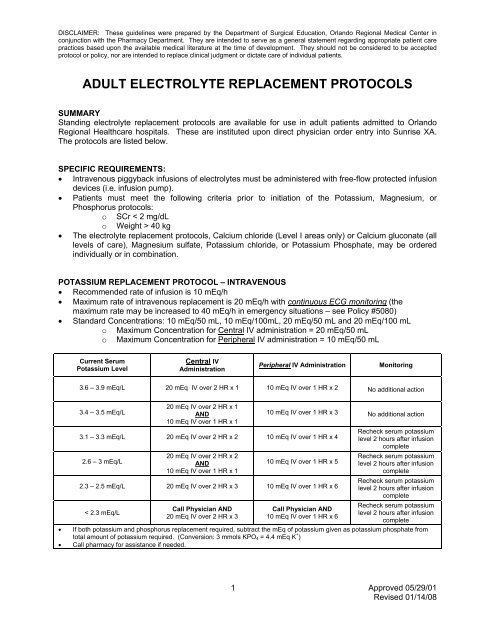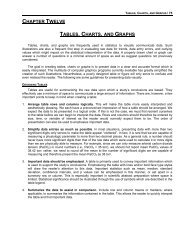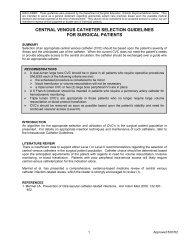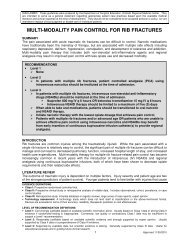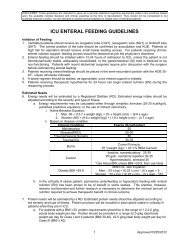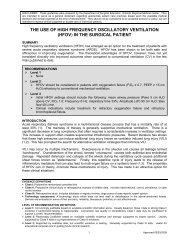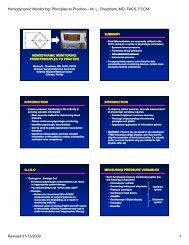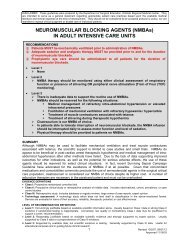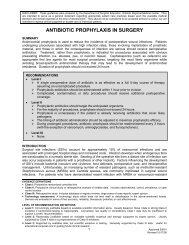adult electrolyte replacement protocols - SurgicalCriticalCare.net
adult electrolyte replacement protocols - SurgicalCriticalCare.net
adult electrolyte replacement protocols - SurgicalCriticalCare.net
Create successful ePaper yourself
Turn your PDF publications into a flip-book with our unique Google optimized e-Paper software.
DISCLAIMER: These guidelines were prepared by the Department of Surgical Education, Orlando Regional Medical Center in<br />
conjunction with the Pharmacy Department. They are intended to serve as a general statement regarding appropriate patient care<br />
practices based upon the available medical literature at the time of development. They should not be considered to be accepted<br />
protocol or policy, nor are intended to replace clinical judgment or dictate care of individual patients.<br />
ADULT ELECTROLYTE REPLACEMENT PROTOCOLS<br />
SUMMARY<br />
Standing <strong>electrolyte</strong> <strong>replacement</strong> <strong>protocols</strong> are available for use in <strong>adult</strong> patients admitted to Orlando<br />
Regional Healthcare hospitals. These are instituted upon direct physician order entry into Sunrise XA.<br />
The <strong>protocols</strong> are listed below.<br />
SPECIFIC REQUIREMENTS:<br />
• Intravenous piggyback infusions of <strong>electrolyte</strong>s must be administered with free-flow protected infusion<br />
devices (i.e. infusion pump).<br />
• Patients must meet the following criteria prior to initiation of the Potassium, Magnesium, or<br />
Phosphorus <strong>protocols</strong>:<br />
o SCr < 2 mg/dL<br />
o Weight > 40 kg<br />
• The <strong>electrolyte</strong> <strong>replacement</strong> <strong>protocols</strong>, Calcium chloride (Level I areas only) or Calcium gluconate (all<br />
levels of care), Magnesium sulfate, Potassium chloride, or Potassium Phosphate, may be ordered<br />
individually or in combination.<br />
POTASSIUM REPLACEMENT PROTOCOL – INTRAVENOUS<br />
• Recommended rate of infusion is 10 mEq/h<br />
• Maximum rate of intravenous <strong>replacement</strong> is 20 mEq/h with continuous ECG monitoring (the<br />
maximum rate may be increased to 40 mEq/h in emergency situations – see Policy #5080)<br />
• Standard Concentrations: 10 mEq/50 mL, 10 mEq/100mL, 20 mEq/50 mL and 20 mEq/100 mL<br />
o Maximum Concentration for Central IV administration = 20 mEq/50 mL<br />
o Maximum Concentration for Peripheral IV administration = 10 mEq/50 mL<br />
Current Serum<br />
Potassium Level<br />
Central IV<br />
Administration<br />
Peripheral IV Administration<br />
Monitoring<br />
3.6 – 3.9 mEq/L 20 mEq IV over 2 HR x 1 10 mEq IV over 1 HR x 2 No additional action<br />
3.4 – 3.5 mEq/L<br />
20 mEq IV over 2 HR x 1<br />
AND<br />
10 mEq IV over 1 HR x 1<br />
3.1 – 3.3 mEq/L 20 mEq IV over 2 HR x 2 10 mEq IV over 1 HR x 4<br />
2.6 – 3 mEq/L<br />
20 mEq IV over 2 HR x 2<br />
AND<br />
10 mEq IV over 1 HR x 1<br />
10 mEq IV over 1 HR x 3 No additional action<br />
10 mEq IV over 1 HR x 5<br />
2.3 – 2.5 mEq/L 20 mEq IV over 2 HR x 3 10 mEq IV over 1 HR x 6<br />
< 2.3 mEq/L<br />
Call Physician AND<br />
20 mEq IV over 2 HR x 3<br />
Call Physician AND<br />
10 mEq IV over 1 HR x 6<br />
Recheck serum potassium<br />
level 2 hours after infusion<br />
complete<br />
Recheck serum potassium<br />
level 2 hours after infusion<br />
complete<br />
Recheck serum potassium<br />
level 2 hours after infusion<br />
complete<br />
Recheck serum potassium<br />
level 2 hours after infusion<br />
complete<br />
• If both potassium and phosphorus <strong>replacement</strong> required, subtract the mEq of potassium given as potassium phosphate from<br />
total amount of potassium required. (Conversion: 3 mmols KPO 4 = 4.4 mEq K + )<br />
• Call pharmacy for assistance if needed.<br />
1 Approved 05/29/01<br />
Revised 01/14/08
POTASSIUM REPLACEMENT PROTOCOL – ORAL or ENTERAL (PT)<br />
• Standard dosage forms: KCl 20mEQ tablet or KCl 10% solution (20 mEq/15 mL)<br />
Current Serum<br />
Potassium Level<br />
Total Potassium Replacement<br />
Monitoring<br />
3.7 – 3.9 mEq/L 20 mEq KCl PO/Per feeding tube x 1 dose No additional action<br />
3.5 – 3.6 mEq/L 20 mEq KCl PO/Per feeding tube Q2H x 2 doses No additional action<br />
3.3 – 3.4 mEq/L 20 mEq KCl PO/Per feeding tube Q2H x 3 doses Recheck serum potassium level 4 hours<br />
after last oral dose<br />
3.1 – 3.2 mEq/L 20 mEq KCl PO/Per feeding tube Q2H x 4 doses Recheck serum potassium level 4 hours<br />
after last oral dose<br />
< 3.1 mEq/L<br />
Call Physician AND<br />
20 mEq KCl PO/Per feeding tube Q2H x 4 doses<br />
Recheck serum potassium level 4 hours<br />
after last oral dose<br />
MAGNESIUM REPLACEMENT PROTOCOL<br />
• Infusions should be no faster than 1gm of magnesium sulfate every 30 minutes.<br />
• Standard Concentrations: 1 gm/100 mL and 2 gm/50 mL<br />
Current Serum Magnesium Level Total Magnesium Replacement Monitoring<br />
1.5 – 2 mEq/L 2 grams Magnesium Sulfate IV over 1 HR No additional action<br />
0.9 – 1.4 mEq/L<br />
< 0.9 mEq/L<br />
2 grams Magnesium Sulfate IV over 1 HR x<br />
2 doses<br />
Call Physician AND<br />
2 grams Magnesium Sulfate IV over 1 HR x<br />
2 doses<br />
Recheck serum magnesium level 2 hours<br />
after infusion complete<br />
Recheck serum magnesium level 2 hours<br />
after infusion complete<br />
2 Approved 05/29/01<br />
Revised 01/14/08
PHOSPHORUS REPLACEMENT PROTOCOL<br />
• Replacement must be ordered in mmol of phosphorus.<br />
• Recommended rate = 3mmol/hr (= 4.4 mEq/h of K)<br />
• Maximum rate = 10 mmol/hr (= 15 mEq/h of K)<br />
• Use SODIUM phosphate for patients with serum potassium > 4.5 mEq/L and serum sodium < 145<br />
mEq/L<br />
• Standard Concentrations:<br />
o Potassium Phosphate: 15 mmol/250 mL and 21 mmol/250 mL<br />
o Sodium Phosphate: 15 mmol/250 mL, 21 mmol/250 mL, and 30 mmol/250 mL<br />
Current Serum<br />
Phosphorus Level<br />
Total Phosphorus Replacement<br />
Monitoring<br />
2 – 2.5 mg/dL 15 mmol Potassium Phosphate IV over 4 HR No additional action<br />
1 – 1.9 mg/dL 21 mmol Potassium Phosphate IV over 4 HR<br />
Recheck serum phosphorus level 2 hours<br />
after infusion complete<br />
< 1 mg/dL<br />
Call Physician AND<br />
30 mmol Potassium Phosphate IV over 4 HR<br />
(Administered as: 15 mmol Potassium<br />
Phosphate IV Q2H x 2 doses)<br />
Recheck serum phosphorus level 2 hours<br />
after infusion complete<br />
• If both potassium and phosphorus <strong>replacement</strong> required, subtract the mEq of potassium given as potassium phosphate from<br />
total amount of potassium required. (Conversion: 3 mmols KPO 4 = 4.4 mEq K + )<br />
• Call pharmacy for assistance if needed.<br />
CALCIUM REPLACEMENT PROTOCOL<br />
• You must specify the salt form (gluconate or chloride)<br />
• Calcium chloride:<br />
o Reserved for Level I areas only<br />
o Must be administered via a central line<br />
o Maximum rate = 1 gm IV over 10 minutes<br />
• Calcium gluconate:<br />
o May be used in all levels of care<br />
o Administration via a central line is preferred; however, it may be given peripherally with<br />
adequate IV access.<br />
o Maximum rate = 3 gm IV over 10 minutes<br />
• Standard concentrations:<br />
o Calcium chloride: 1 gm/50 mL, 2 gm/100 mL, 3 gm/150 mL<br />
o Calcium gluconate: 1 gm/50 mL, 2 gm/100 mL<br />
Current Ionized<br />
Calcium Level<br />
Total Calcium GLUCONATE<br />
Replacement<br />
Total Calcium CHLORIDE<br />
Replacement<br />
(Level I areas only)<br />
Monitoring<br />
1 – 1.1 mmol/L 1 gram IV over 1 HR 1 gram IV over 1 HR No additional action<br />
0.85 – 0.99 mmol/L 2 grams IV over 1 HR 2 grams IV over 1 HR Recheck serum ionized calcium<br />
2 hours after infusion complete<br />
< 0.85 mmol/L Call Physician AND<br />
2 grams IV over 1 HR<br />
Call Physician AND<br />
3 grams IV over 1 HR<br />
Recheck serum ionized calcium<br />
2 hours after infusion complete<br />
3 Approved 05/29/01<br />
Revised 01/14/08


